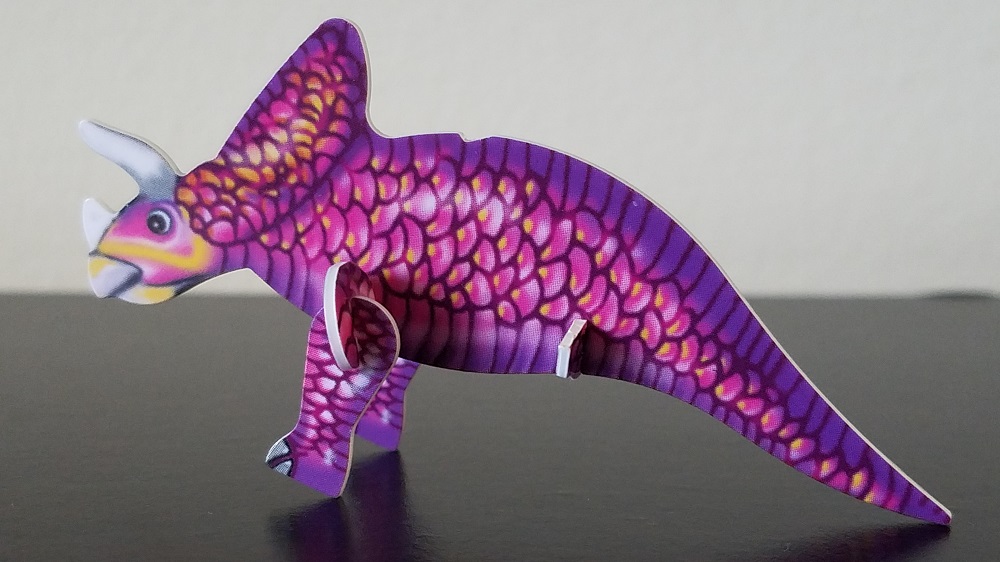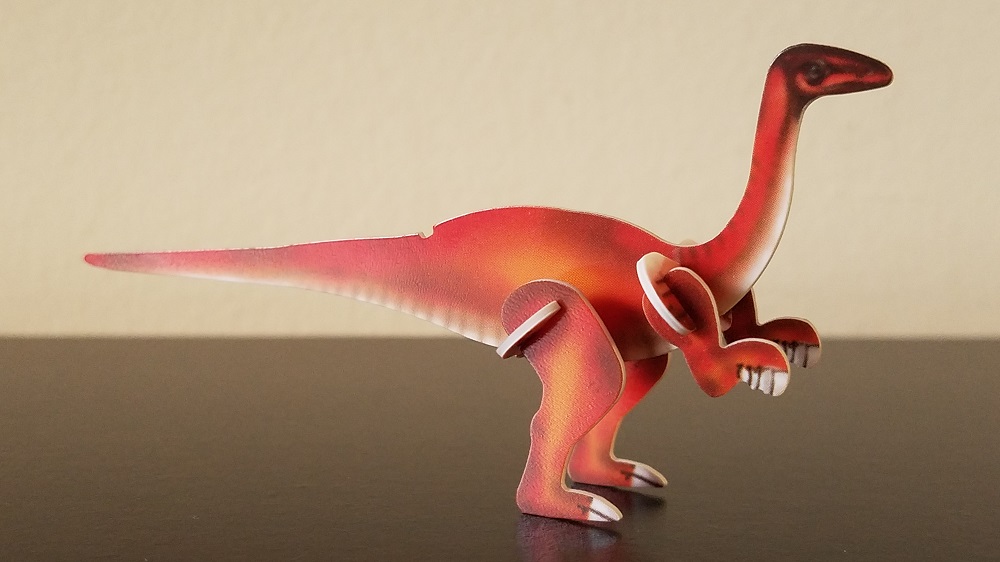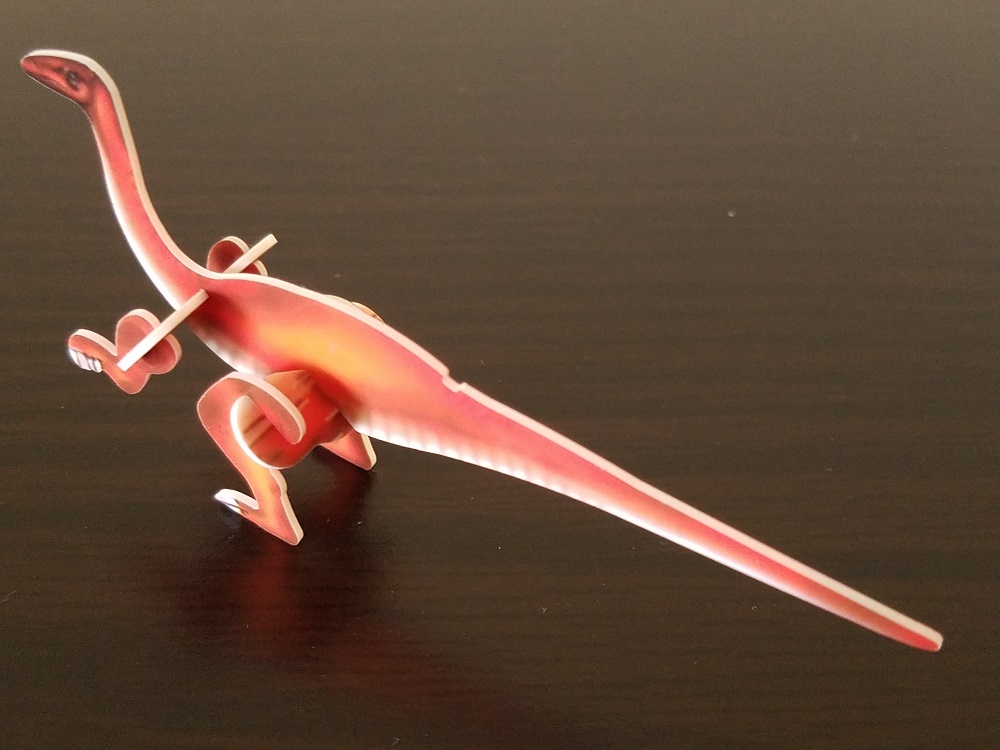Despite only featuring dinosaurs, this set still offers an interesting variety of genera; but how well do the designs hold up?
Welcome to the fourth and final review for the Z-Cardz dinosaur figurines, part of the larger Z-Cardz line that began in 2001. Produced by a small company named California Creations, Z-Cardz were a pioneer brand in what are now commonly known as Constructible Card/Strategy games, involving punch-out card figures which can be bought in a variety of different packs and sets. A total of twenty dinosaurs (plus a couple other extinct creatures) were released over four sets in the Z-Cardz line, two labeled “Dinosaur” and two labeled “Prehistoric.” Ironically, the second Prehistoric Set is the only set of the four which doesn’t feature a non-dinosaur (deliberate or accidental), however, the genera included still offer an interesting variety consistent with the choices seen in prior sets. Do the designs hold up better, though?

Figure #216 is Triceratops, the most famous genus included in this set. I do commend Z-Cardz for not clumping the “biggest-name” dinosaurs into only one or two sets, instead spreading them out between lots of lesser-known genera. Now, Z-Cardz has made some interesting choices in their interpretations of dinosaurs, but in case you’re wondering: no, Z-Cardz did not boldly reinterpret Triceratops as a Skullcrawler-style biped. The downside to card models like these is that they tend to be delicate, and a little too much force during construction or play can lead to breakage. My poor Triceratops was such a victim at some point in the past I’ve since forgotten, and regrettably it’s the only one I have available for review. Damage aside, the model appears surprisingly long in skull and body proportions, more reminiscent of the related genus Torosaurus (which is funny in hindsight, since Dr. Jack Horner argued in the years following the toy’s release that the two genera might actually be one and the same). Only one brow horn is modeled on the figure, since the head is part of the same base body piece; the resulting appearance can be a little deceptive about how many horns the animal actually would have. The face has a hefty, finch-like beak and wide round eyes which suggest the animal is very excited about something on the ground before it. The body has very large, irregular overlapping scales painted across the body and the frill alike, with even bigger overlapping scutes along the belly and back. Although we have since found legitimate skin preservations of Triceratops, these kinds of scales don’t really match what we know – although that couldn’t have been helped at the time of the toy’s production. The color scheme of the figure is a vibrant purple and pink, with glossy scales and yellow highlights to the face and frill. Is it a pretty color scheme? I think it is. Is it a REALISTIC scheme for a robust herbivore like Triceratops? I’m not so sure about that one. All in all, it’s a predictably quirky take by Z-Cardz.


Figure #217 is Corythosaurus, the last of several hadrosaurs included in this line. Like the Lambeosaurus and Parasaurolophus before it, this one is posed upright with its forelimbs outward and its tail along the ground. The snout is pointed and curved outward, as if trying a little too hard to match the “duckbill” moniker so often associated with these dinosaurs. The animal’s rounded crest is faithfully present, though enlarged – probably to be more distinguishable on the small figure. The forelimbs are also quite enlarged on the toy, rather ironically as the animal isn’t even posed as a quadruped (which is typically considered the main stance for Corythosaurus). Hadrosaur “hands” are typically as fairly narrow and compact (or even hoofed now), but the hands of this Corythosaurus are quite broad with spread hands; maybe it’s in the middle of a threat display? The figure is somewhat slender rather than deep and stocky, although hadrosaurs were bigger animals than they get credit for. More large, irregular scales are painted over the body, obscured somewhat by the deep blue coloration. The only real highlights to the color are in the white toes and fingers and the yellow crest. All in all, this is kind of a drab take on the dinosaur.


Figure #218 is the maligned “egg thief” Oviraptor, presented here with a stolen egg in each of its hands. Z-Cardz is no stranger to stereotypes for their dinosaurs, but here the greediness of the figure is actually breaking accuracy on multiple levels, since Oviraptor had no opposable thumbs, nor could it twist its wrists. The head looks rather small for its body, but since the original Oviraptor fossils are actually very fragmentary, the proportions might not be as off as they appear. Oviraptor is typically depicted with a head crest, which is included here. The beak also appears to be present, although it’s a bit blunt and oddly shaped, like the animal is trying to pucker up. The rest of the figure is pretty nondescript in shape, with a rounded body, a tail sticking straight back, and large feet to provide balance. The same general scaling pattern on the previous two figures is used here, with a bright green stripe and blue and pink highlights along the back of the figure, over a primary color scheme of warm orange and brown. In certain ways, this is one of the more dynamic Z-Cardz, but those same design choices also make it one of the most awkward.


Figure #219 is Psittacosaurus, the “parrot lizard” and the second marginocephalian dinosaur in this set. Since the 2010s, Psittacosaurus might be one of the best-known dinosaurs from fossil evidence, but back in 2001, there was more wiggle room. Z-Cardz decided to play up the parrot parallel by giving their Psittacosaurus a smooth, rounded head with extra emphasis on the size of the beak, as well as a bright green color scheme with stripes of red, yellow, blue, and purple along the face and flanks, akin to a tropical bird. It’s a pleasant enough color scheme, although we actually know enough about the genus’s genuine color patterns now to know this is not correct. More large scales adorn the figure’s body, and the figure is posed squarely on all fours. Depictions of Psittacosaurus have bounced back and forth regarding the animal’s most likely posture, so I won’t fault Z-Cardz for making this choice rather than a biped (although it would be interesting to learn how and why they made these choices from figure to figure). Sadly, as you can see in my photos, this Psittacosaurus is yet another victim of rough play or construction, although in this case it’s at least only one limb. Overall, the color scheme balances out what is an otherwise plain model, but this model arguably holds up better than most others in this line, newer discoveries notwithstanding.


Figure #220, the last and possibly most unique dinosaur in the Z-Cardz line, is Segnosaurus. Therizinosaurs don’t get a lot of attention in pop culture despite their quirky appearances, so any “scythe lizard” merchandise is welcome – at least in theory. The Z-Cardz model is very reminiscent of artwork one might see from the 1990s, such as in Dorling Kindersley publications. The model’s pose is especially static and rigid in appearance, like one might see from a computerized character model before animation, but for the most part, the anatomy looks reasonably correct for what was known of the animal at the time. The hands, regrettably, are scrunched into pronated position, as is so often mistakenly done for theropods. The tail is also excessively long for a therizinosaur, which does cause some balancing issues for the model. Unlike the other models in this set, no scales have been painted on Segnosaurus, instead leaving the model looking smooth-skinned apart from some slight texturing along the neck and belly. Coloration for the Segnosaurus consists of fiery red-orange, with faint brown patches for shading and a white underbelly. It’s not the most striking Z-Cardz dino, but it holds up fairly well, and it’s nice to see another obscure taxon get a bit of attention.


This review wraps up the Z-Cardz series for the Dinosaur Toy Blog. Dinosaurs were only one of many “groups” of animals/items/characters which Z-Cardz released during their active years. Although they seem quaint at best now, and other companies have been more successful with the constructible card game concept, I can at least vouch for the Z-Cardz dinos as being successfully entertaining when I was a kid. These days, Z-Cardz are all but gone from the regular retailers, but they do show up from time to time to time on eBay like just about everything else.

Disclaimer: links to Ebay and Amazon on the DinoToyBlog are affiliate links, so we make a small commission if you use them. Thanks for supporting us!




It did not occur to me until just now that this is the very first time Segnosaurus has appeared on the DTB.
Interesting to see Segnosaurus in particular. It seemed to have some minor notoriety around this time, but it never really translated into toys except for one really hideous remote control contraption.